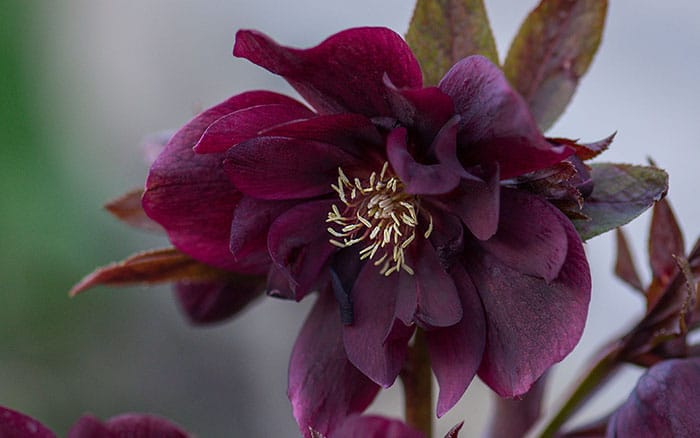March is the month when many spring flowering plants start to produce their flowers in earnest. It’s a great time of year for appreciating just how many different types of flowers are starting to appear for March gardens. Here are ten of the best performing spring plants:
1. Helleborus x hybridus ‘Harington Shades of the Night’ (Hellebore)
Hellebores are beautiful flowering spring plants that will flower for weeks on end. This cultivar, as its name suggests, produces handsome, large, outward-facing, deep purple-black flowers. Traditionally planted in semi-shade, they will also grow well in full sun if the soil around them remains moist. Remove old leaves in January to enable the emerging flowers to be shown off to best effect.

- Flowers from February to April
- Hardy
- Grows to 45cm tall and 60cm wide
- Fertile, moist but well-drained soil
- Part shade
- Exposed
2. Pulmonaria ‘Raspberry Splash’ (Lungwort)
This deciduous, pretty, early-flowering, ground cover plant is ideal for shady locations. Because the silvery spots on its leaves light up dark spaces. At this time of year, it produces vibrant, raspberry-red clusters of bell-shaped flowers. These turn purplish as they age, creating a striking multicoloured effect. Divide large clumps every three to five years after flowering.

- Flowers from March to May
- Hardy
- Grows to 30cm tall and 45cm wide
- Fertile, moist but well-drained soil
- Full sun and part shade
- Exposed
This is a great choice for those wanting an easy-to-care-for, brightly coloured, spring flowering shrub. Because it will produce masses of larger-than-average yellow flowers and requires little or no maintenance during the year. Aside from thinning out crowded stems immediately after flowering as and when needed for March gardens.

- Flowers from March to April
- Hardy
- Grows to 250cm tall and 250cm wide
- Fertile, moist but well-drained soil
- Full sun
- Exposed
4. Chaenomoles species ‘Geisha Girl’ (Flowering quince)
Another easy-to-grow, spring flowering shrub whose bare twigs become smothered in flowers before the glossy, dark green leaves appear. ‘Geisha Girl’ is a compact cultivar and produces double, elegant deep apricot-pink flowers from March until early summer. This is followed by greenish-yellow colour fruit which is edible when cooked. It can be grown in either a flower border or trained against walls for a more formal effect.

- Flowers from March to May
- Hardy
- Grows to 150cm tall and 150cm wide
- Fertile, moist but well-drained soil
- Full sun to light shade
- Exposed
5. Narcissus ‘St Patrick’s Day’ (Daffodil)
Daffodils are easy to grow and establish in most parts of the garden. ‘St Patrick’s Day’ flowers later than other cultivars and so is a great way of extending the daffodil flowering season. It has lemon yellow flowers and also makes a great cut flower.

- Flowers from March to April
- Hardy
- Grows to 45cm tall and 10cm wide
- Fertile, well-drained soil
- Full sun
- Exposed
6. Acacia dealbata (Mimosa)
The mimosa’s scent is exquisite, this graceful evergreen tree produces flowers from the beginning of the year until early spring. But must be given a sheltered, warm site as it’s not reliably hardy. The ball-shaped flowers are fluffy yellow and appear on the ends of their branches.

- Flowers from January to April
- Frost tender
- Grows to 350cm tall and 250cm wide
- Fertile, moist but well-drained soil
- Full sun
- Sheltered
7. Chionodoxa ‘Pink Giant’ (Glory of the snow)
This is one of the first spring flowering bulbs to produce its pretty, pink, star-shaped, flowers. It looks wonderful planted en-masse under and around trees and shrubs or in lawns. If planting in grass avoid mowing until the leaves have died down. This enables the bulb to store energy for next year’s flowers and also allows it to self-seed. This is usually about six weeks after flowering finishes.

- Flowers in March
- Hardy
- Grows to 10cm tall and 05cm wide
- Fertile, well-drained, light soil
- Full sun
- Exposed
8. Bergenia cordifolia ‘Purpurea’ (Elephant’s Ears)
Bergenia make great front-of-border plants with their large, oval-shaped leaves, and this cultivar is no exception. Its red-flushed leaves turn a shade of rich purple during winter, the colour more pronounced if grown in poor soil. Tall, red stems with clusters of cerise pink flowers are produced in late winter, lasting until early spring.

- Flowers from March to April
- Hardy
- Grows to 60cm tall and 75cm wide
- Fertile, moist but well-drained soil
- Full sun to deep shade
- Exposed
9. Muscari latifolium (Grape hyacinth)
A small plant that packs a big punch and is best planted en-masse in March gardens for the best effect. Its flowers are two-tone, with the bottom two-thirds being a dark blue and the top third a bright blue. Its leaves are broader than most other grape hyacinths, and looks wonderful grown in grass, pots or mixed flower borders.

- Flowers in March
- Hardy
- Grows to 15cm tall and 10cm wide
- Fertile, moist but well-drained soil
- Full sun to light shade
- Exposed
10. Magnolia stellata (Magnolia)
This slow-growing, compact magnolia is the perfect cultivar for a small garden and one of the earliest to flower. The silky-looking buds open to reveal large, pure white, lightly scented star-shaped flowers. These will flower for several weeks if planted in a sheltered spot out of the way of strong winds.

- Flowers from March to April
- Hardy
- Grows to 300cm tall and 400cm wide
- Fertile, moist but well-drained soil
- Full sun
- Sheltered
Make sure your March garden is looking has some welcome colour as we enter spring this month.

Where do we buy peanut seeds, or do you just sow peanuts from the supermarkets.